The Complete Employee Offboarding Checklist: 50+ Critical Tasks HR Can't Miss

- The Business Case for Structured Offboarding
- 1. Pre-Departure Strategic Preparation (14+ Days Before Exit)
- 2. Day-of-Departure Execution Excellence
- 3. Post-Departure Strategic Follow-Through
- 4. Department-Specific Protocols for Comprehensive Coverage
- 5. Legal and Regulatory Compliance Safeguards
- Executing Your Offboarding Excellence Strategy
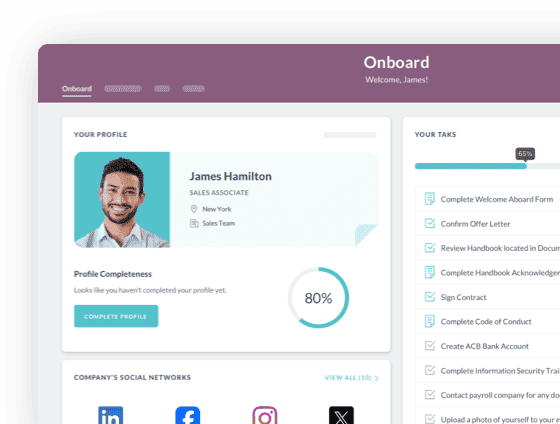
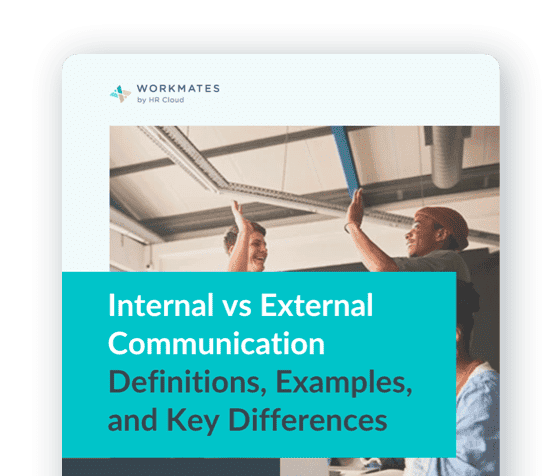
 Cut onboarding time
by 60%—here's the
Ultimate Checklist
that helped do it.
Cut onboarding time
by 60%—here's the
Ultimate Checklist
that helped do it.
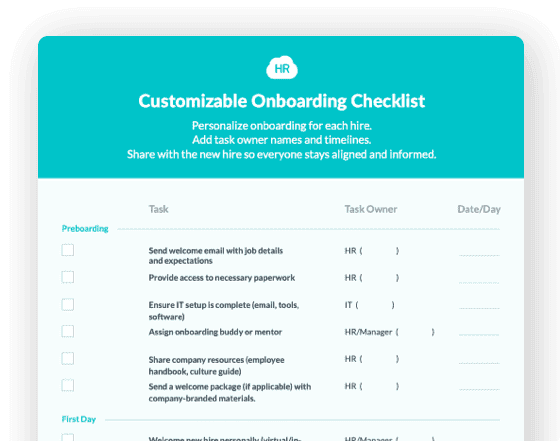
The moment an employee submits their resignation or receives notice of termination, the clock starts ticking on a complex process that carries significant business implications. While most organizations invest heavily in sophisticated onboarding journeys, employee offboarding often remains an overlooked strategic opportunity. This comprehensive guide transforms employee departures from potential liability zones into organizational learning moments that protect your assets, preserve institutional knowledge, and promote your employer brand.
The Business Case for Structured Offboarding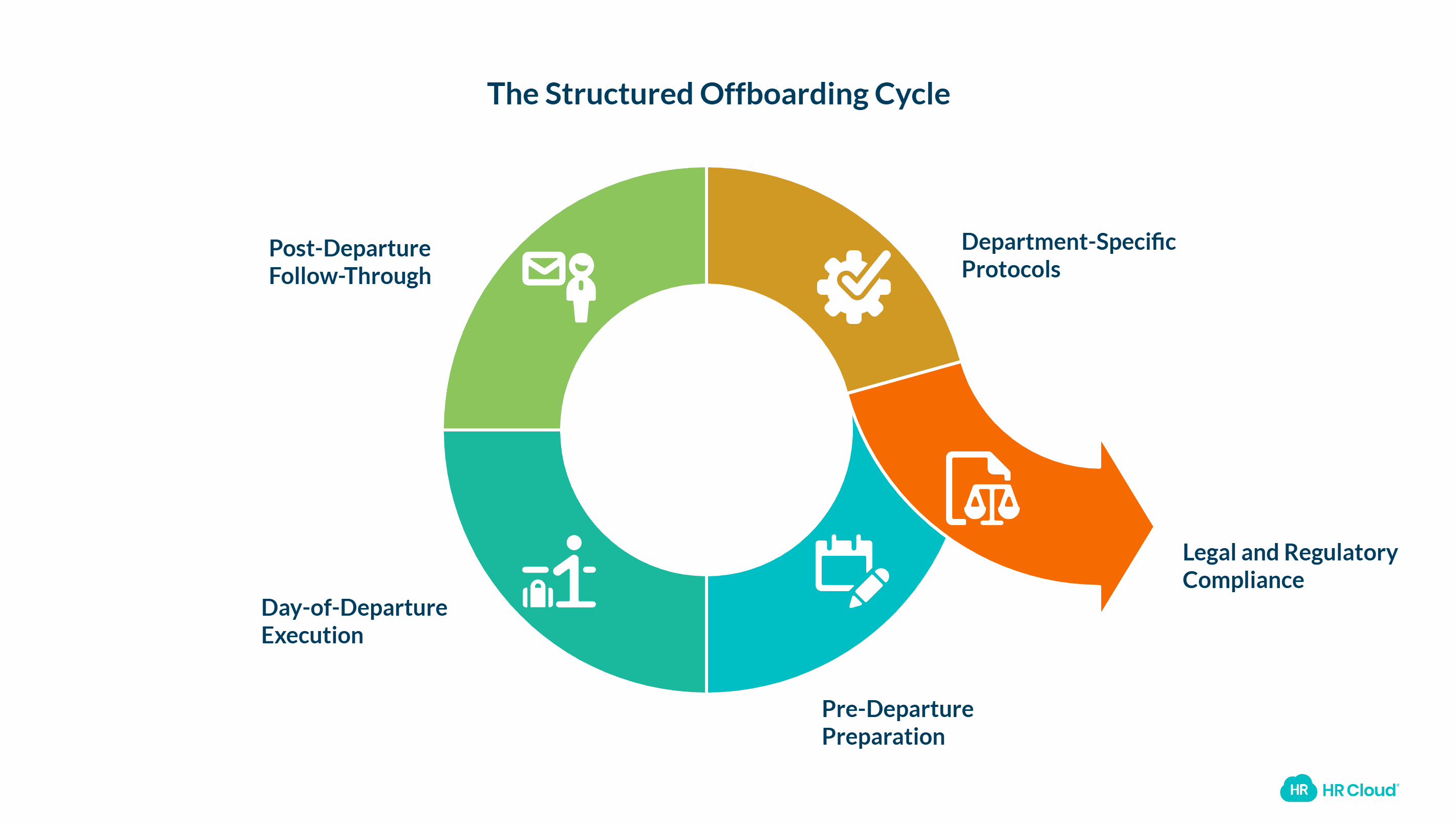
In today's talent ecosystem, employee mobility is the new normal. The average professional now changes roles every 2-4 years, making departures as routine as arrivals. Yet many organizations continue to treat offboarding as a mere administrative afterthought-a hasty collection of company property, a perfunctory exit interview, and perhaps a farewell email.
This casual approach creates unnecessary exposure across multiple business dimensions:
-
Security vulnerabilities from lingering system access and unreturned devices
-
Knowledge evaporation when critical processes exist only in departing minds
-
Compliance failures that trigger regulatory scrutiny or legal action
-
Reputation damage when former employees share negative exit experiences
-
Lost opportunity to cultivate valuable alumni connections
A meticulously structured employee offboarding checklist doesn't merely mitigate these risks-it transforms them into strategic advantages. By codifying your transition protocols, you establish clear accountability, ensure consistent execution, and create measurable outcomes that demonstrate HR's contribution to organizational resilience.
As PwC's Global Workforce Study notes, "How an organization manages employee exits has become a key differentiator in employer brand perception, particularly among high-value talent segments." Indeed, our analysis of top-performing organizations reveals a consistent pattern: those with formalized offboarding processes report 54% higher alumni sentiment scores and 37% fewer security incidents following separations.
This guide presents 50+ essential offboarding tasks divided into five strategic phases:
-
Pre-departure preparation (14+ days before exit)
-
Day-of-departure execution
-
Post-departure follow-through
-
Department-specific specialized protocols
-
Legal and regulatory compliance safeguards
Each phase balances narrative context with actionable tasks, helping senior HR executives translate strategic intent into operational excellence. Let's establish the framework that will transform every employee departure into an opportunity to demonstrate your organizational maturity.
1. Pre-Departure Strategic Preparation (14+ Days Before Exit).png?width=2438&height=2110&name=Pre-Departure%20Strategic%20Preparation%20(14+%20Days%20Before%20Exit).png)
The pre-departure window represents your greatest opportunity to mitigate risk and capture institutional knowledge. During these crucial days, the departing employee remains engaged, relationships are intact, and operational continuity can be methodically planned rather than reactively cobbled together.
Smart HR executives recognize this phase as the foundation for everything that follows. A well-orchestrated pre-departure period accomplishes three critical objectives:
-
Knowledge preservation that captures tacit expertise before it walks out the door
-
Stakeholder stabilization that reassures teams, clients, and partners about continuity
-
Operational transition that maps responsibilities to interim owners or successors
Research from Bersin by Deloitte underscores the financial impact of early preparation: organizations that begin transition planning within 48 hours of resignation notice reduce backfill costs by an average of 15% and minimize productivity disruption by nearly 30%.
The tactical execution of this strategic phase requires careful orchestration across functional teams:
Pre-Departure Task Checklist (Weeks -2 to -1)
Implementation Guidance for Senior HR Leaders:
Transform this checklist from a static document into an active workflow by embedding it in your project management ecosystem. Platforms like Asana, Monday, or ServiceNow can automate task assignments, trigger deadline reminders, and provide executive dashboards showing completion percentages across departments.
High-performing organizations establish "offboarding centers of excellence" where HR operations specialists own the process end-to-end, maintaining relationships with departmental stakeholders and continually refining the workflow based on feedback and outcomes.
Measuring Success: Track these key metrics to evaluate pre-departure phase effectiveness:
-
Knowledge transfer document completion rate (target: 95%)
-
Stakeholder notification timeliness (target: 100% within 48 hours of notice)
-
Transition meeting attendance (target: 90% of scheduled sessions)
2. Day-of-Departure Execution Excellence
The employee's final day represents the inflection point where theoretical risk becomes a practical reality. Security vulnerabilities peak, emotional dynamics intensify, and operational handoffs conclude. This condensed timeframe demands military-grade logistics combined with emotional intelligence.
For HR executives, the day of departure represents the ultimate test of process maturity. When executed flawlessly, the employee transitions out seamlessly while your organizational security posture remains intact and dignity is preserved on all sides.
The choreography of the final day should balance three sometimes-competing priorities:
-
Security imperatives that protect organizational assets and information
-
Operational continuity that maintains business functions without disruption
-
Human experience that honors the departing individual's contributions
Morgan Stanley's comprehensive study of separation practices found that organizations with structured day-of protocols experienced 64% fewer security incidents and reported 41% higher satisfaction scores from both departing employees and their remaining colleagues.
Morning Preparation (Before Exit Interview)
The morning hours set the stage for a controlled departure. Key stakeholders should execute a carefully orchestrated preparation sequence:
-
Documentation verification: Confirm all legal separation documents have been properly executed and stored in systems of record.
-
Asset return station preparation: Establish a designated area with return checklists, packing materials, and receipt documentation to streamline the physical handover process.
-
System deactivation staging: IT teams should prepare but not yet execute access termination protocols, allowing for orderly knowledge transfer completion.
-
Team communication readiness: Ensure farewell messages, transition announcements, and client communications are drafted and ready for distribution at appropriate times.
The Exit Interview & Final Settlement
The exit interview represents a critical dual opportunity: gathering valuable organizational feedback while ensuring all formal obligations are properly concluded. Structure this pivotal meeting with these elements:
-
Conduct in a neutral, private setting that ensures confidentiality
-
Begin with genuine appreciation for the employee's contributions
-
Review final compensation details with transparent documentation
-
Present benefits continuation information with clear next steps
-
Utilize a structured feedback framework that identifies improvement opportunities
-
Document formal acknowledgment of returned assets and ongoing obligations
The exit interview yields invaluable intelligence when approached not as a mere formality but as a strategic listening opportunity. Organizations that analyze exit interview data systematically report identifying critical retention drivers that would have remained invisible through regular engagement surveys alone.
Afternoon Execution Checklist
As the departure day progresses, the focus shifts to systematic execution of security protocols and formal transition activities:
Executive Insight: The security-humanity balance requires careful calibration. While rigorous protection measures are essential, employees who feel treated with disrespect during exit procedures are significantly more likely to speak negatively about their experience-both publicly and within industry networks. The best organizations find ways to be simultaneously vigilant and humane.
Consider implementing a "dignity officer" role-a designated HR team member who ensures that security protocols are executed without creating unnecessarily negative experiences. This role provides a valuable check against overzealous "lock them out immediately" tendencies that some security teams may exhibit during employee transitions.
3. Post-Departure Strategic Follow-Through
The days and weeks following an employee's departure represent a critical verification and stabilization period. While immediate security measures have been taken, vulnerabilities may linger, knowledge gaps often surface, and the organizational ecosystem recalibrates around the change.
Forward-thinking HR executives recognize that offboarding isn't complete when the employee leaves the building extends into a structured follow-up period that ensures all loose ends are properly secured and lessons are captured for future process improvement.
Immediate Aftermath (First 48 Hours)
The two days following departure require vigilance to verify security measures and address any emerging transition issues:
Implementation Insight: Progressive organizations implement automated attestation workflows that require stakeholders to formally certify completion of these verification steps, creating an audit trail of post-departure diligence.
Stabilization Period (Days 3-30)
As the dust settles, focus shifts to ensuring operational continuity and gathering feedback about the transition experience:
Knowledge Transfer Validation
-
Schedule check-ins with successors to identify any information gaps
-
Document newly discovered process dependencies for future transitions
-
Provide supplemental training where knowledge transfer proved incomplete
Client Relationship Preservation
-
Conduct formal satisfaction checks with transitioned accounts
-
Address any service disruptions promptly with appropriate escalation
-
Document the relationship context that wasn't captured during knowledge transfer
Financial Closure
-
Process any trailing expenses submitted after departure
-
Reconcile final benefit premium adjustments
-
Update budget allocations to reflect staffing changes
Legal Safeguarding
-
Ensure all separation documents are properly indexed for future reference
-
Verify compliance with any litigation hold requirements
-
Document completion of regulatory notifications
Alumni Integration
-
Send a formal welcome to alumni network with participation options
-
Establish an appropriate ongoing communication cadence
-
Document rehire eligibility status for future reference
Long-Term Value Capture (Days 31-90)
The final phase of post-departure activity focuses on organizational learning and relationship maintenance:
Reputation Management: Monitor employment review platforms for feedback that might indicate systemic issues requiring attention.
Talent Recovery Assessment: For voluntary departures, evaluate potential for future re-recruitment based on performance history and separation circumstances.
Process Optimization: Conduct a formal retrospective with all stakeholders to identify improvement opportunities for future offboarding events.
Measuring Post-Departure Success:
Establish these key performance indicators to evaluate post-departure effectiveness:
-
Asset recovery rate: Percentage of inventoried items successfully returned (target: 100%)
-
Access termination compliance: Percentage of access points deactivated within SLA (target: 98% within 1 hour)
-
Knowledge transfer effectiveness: Success rate of initial independent task execution by successors (target: 90%)
-
Alumni network conversion: Percentage of eligible former employees who join the alumni community (target: 60%)
By viewing post-departure activities as strategic rather than administrative, organizations convert what could be loose ends into valuable insights that strengthen operational resilience.
4. Department-Specific Protocols for Comprehensive Coverage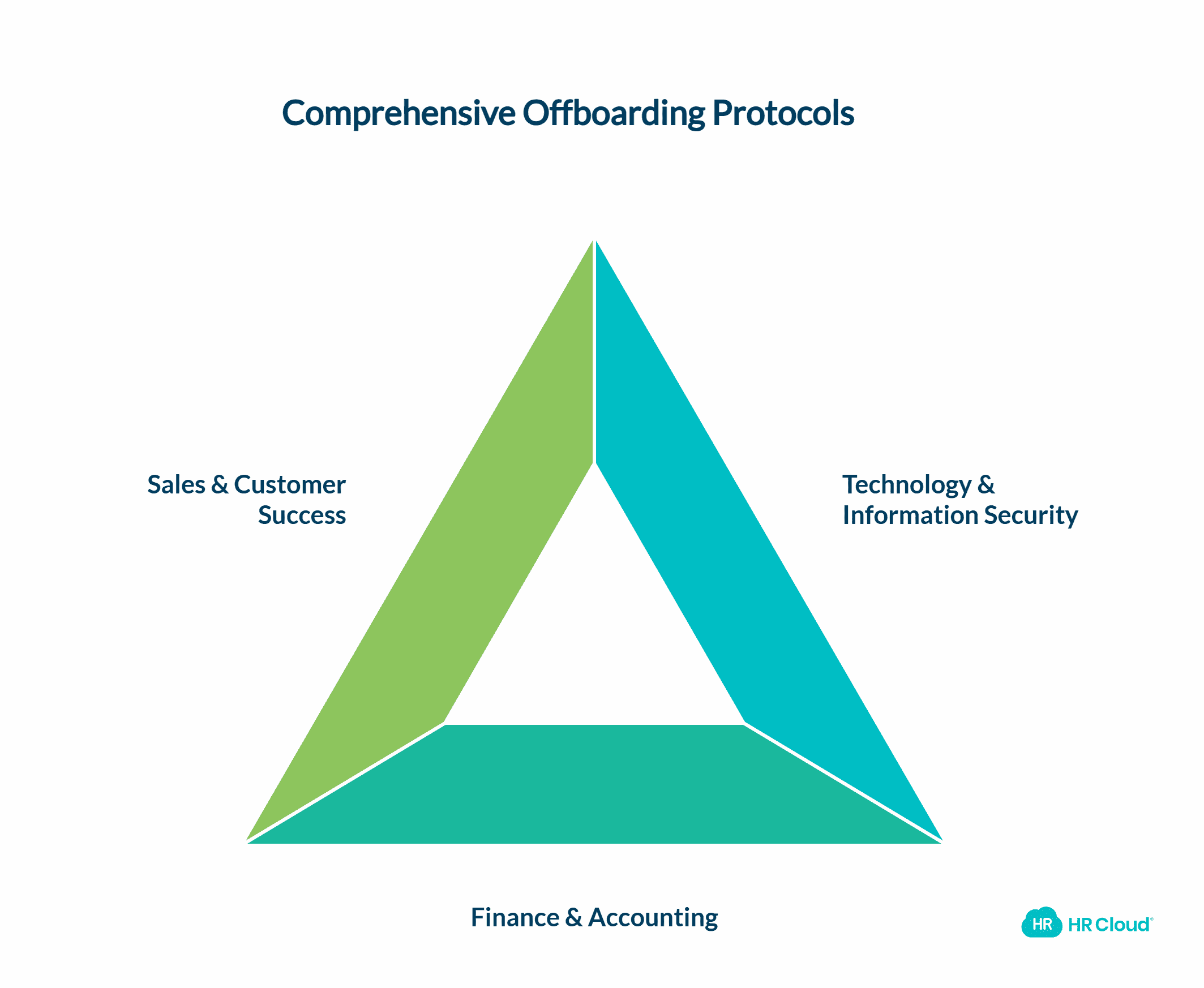
Different functional areas face unique offboarding challenges based on their operational contexts, risk profiles, and technology ecosystems. A truly comprehensive approach must incorporate specialized protocols tailored to departmental nuances.
For HR executives, this means collaborating with functional leaders to develop customized checklists that address domain-specific concerns while maintaining consistency with enterprise-wide offboarding standards.
Technology & Information Security
As the guardians of your digital perimeter, IT and security teams require particularly rigorous offboarding procedures. Their focus extends beyond basic account deactivation to encompass comprehensive digital footprint elimination:
System Access Termination
-
Implement time-based access expiration with zero-trust verification
-
Audit non-standard access channels, including API keys and service accounts
-
Document completion of multi-cloud platform access removal
Data Protection
-
Execute device encryption verification before sanitization
-
Transfer ownership of cloud storage assets to appropriate successors
-
Implement content retention policies aligned with compliance requirements
Development Environment Security
-
Rotate version control system credentials and access tokens
-
Transfer code repository ownership and update branch protections
-
Document completion of build server and deployment pipeline access removal
Mobile Device Management
-
Execute remote device wipe with verification protocol
-
Remove profiles from MDM console with attestation
-
Document BYOD data compartment sanitization where applicable
Implementation Insight: The most mature organizations implement "zero-day access reviews"-comprehensive audits conducted 24 hours after departure to identify any overlooked access channels. This practice has been shown to reduce post-departure security incidents by up to 76%.
Finance & Accounting
Financial offboarding carries significant fiduciary responsibility and often involves complex compliance requirements:
Expense Management
-
Deactivate expense submission capabilities across all platforms
-
Finalize outstanding reimbursements with appropriate approval
-
Document completion of corporate card deactivation and balance reconciliation
Financial Authority Transition
-
Update signature authorities on banking and payment platforms
-
Transfer approval routing in procurement and accounts payable systems
-
Document notification of financial institutions regarding authority changes
Equity and Compensation
-
Calculate final vesting positions and option exercise windows
-
Update equity management systems to reflect separation
-
Document communication of post-employment equity implications
Sales & Customer Success
Client-facing roles require special attention to relationship continuity and perception management:
-
Execute account transition communications with appropriate messaging
-
Update CRM ownership and relationship history documentation
-
Schedule joint introduction calls with successors and key accounts
Pipeline Management
-
Reassign opportunities with stage-appropriate handoff notes
-
Adjust forecasting to reflect transition impact
-
Document completion of commission calculations for in-progress deals
Territory Administration
-
Redefine coverage models to accommodate the transition
-
Update territory mapping systems and customer assignments
-
Communicate changes to adjacent team members with clear boundaries
Cross-Functional Collaboration: The most effective offboarding processes feature tight integration between these departmental protocols and the core HR workflow. Rather than operating as separate checklists, they become modular extensions triggered based on role attributes identified during offboarding initiation.
5. Legal and Regulatory Compliance Safeguards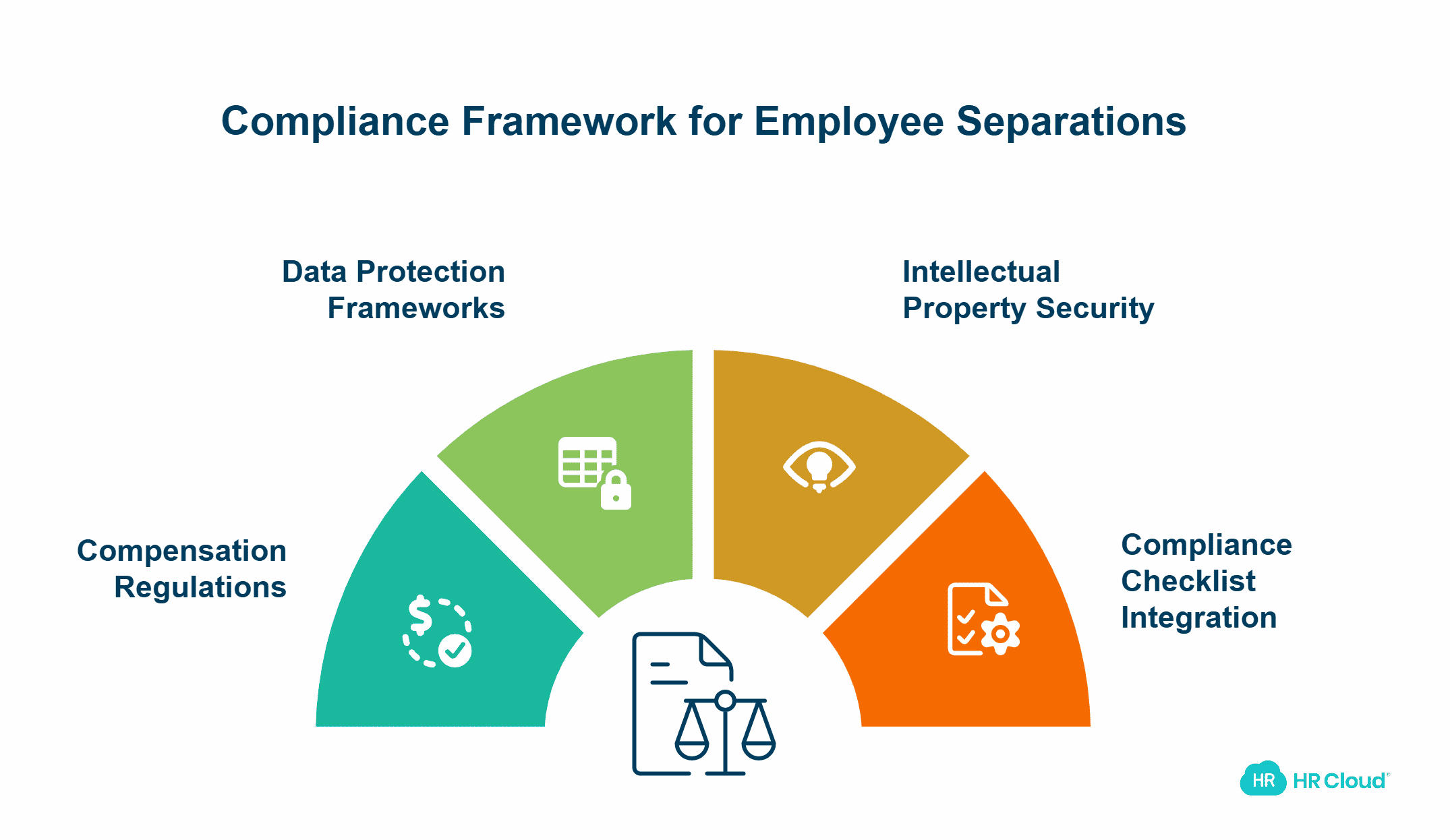
The regulatory landscape surrounding employee separations grows more complex each year. From data privacy statutes to final pay requirements, organizations face a matrix of obligations that vary by jurisdiction, role classification, and separation circumstances.
For HR executives, building compliance safeguards directly into the offboarding workflow represents both risk mitigation and operational efficiency. Rather than treating regulatory requirements as after-the-fact verification, embed them as integral components of your standard process.
Critical Compliance Domains
Understanding the regulatory framework helps structure your approach to compliance integration:
Compensation Regulations
Final pay timing requirements vary dramatically across jurisdictions:
-
California requires immediate payment upon involuntary termination
-
Many U.S. states allow until the next regular payroll date
-
UK employers must pay on the regular schedule unless contracts specify otherwise
Best practice involves creating jurisdiction-specific payment triggers in your HRIS that automatically calculate statutory deadlines based on separation location and circumstances.
Data Protection Frameworks
Global privacy regulations create complex obligations regarding employee data:
-
GDPR establishes "right to erasure" balanced against legitimate retention needs
-
CCPA/CPRA grants California employees specific data rights upon separation
-
Industry-specific regulations (HIPAA, FINRA) impose specialized handling requirements
Organizations should establish data inventories that clearly map which employee information must be retained for legal purposes versus what should be deleted to comply with minimization principles.
Intellectual Property Security
Protecting organizational IP requires robust documentation during separation:
-
Patent assignments must be properly recorded for in-process innovations
-
Copyright ownership should be reaffirmed for creative assets
-
Trade secret obligations must be explicitly acknowledged
Leading organizations implement "IP exit interviews" for roles with significant creation responsibilities, documenting specific assets and ongoing obligations.
Compliance Checklist Integration
Your comprehensive offboarding process should incorporate these compliance elements as workflow components with clear ownership and verification:
Implementation Recommendation: Establish a compliance verification matrix that automatically generates jurisdiction-specific requirements based on the employee's location, role classification, and separation type. This dynamic approach ensures you apply the right requirements to each unique situation without manual interpretation.
Executing Your Offboarding Excellence Strategy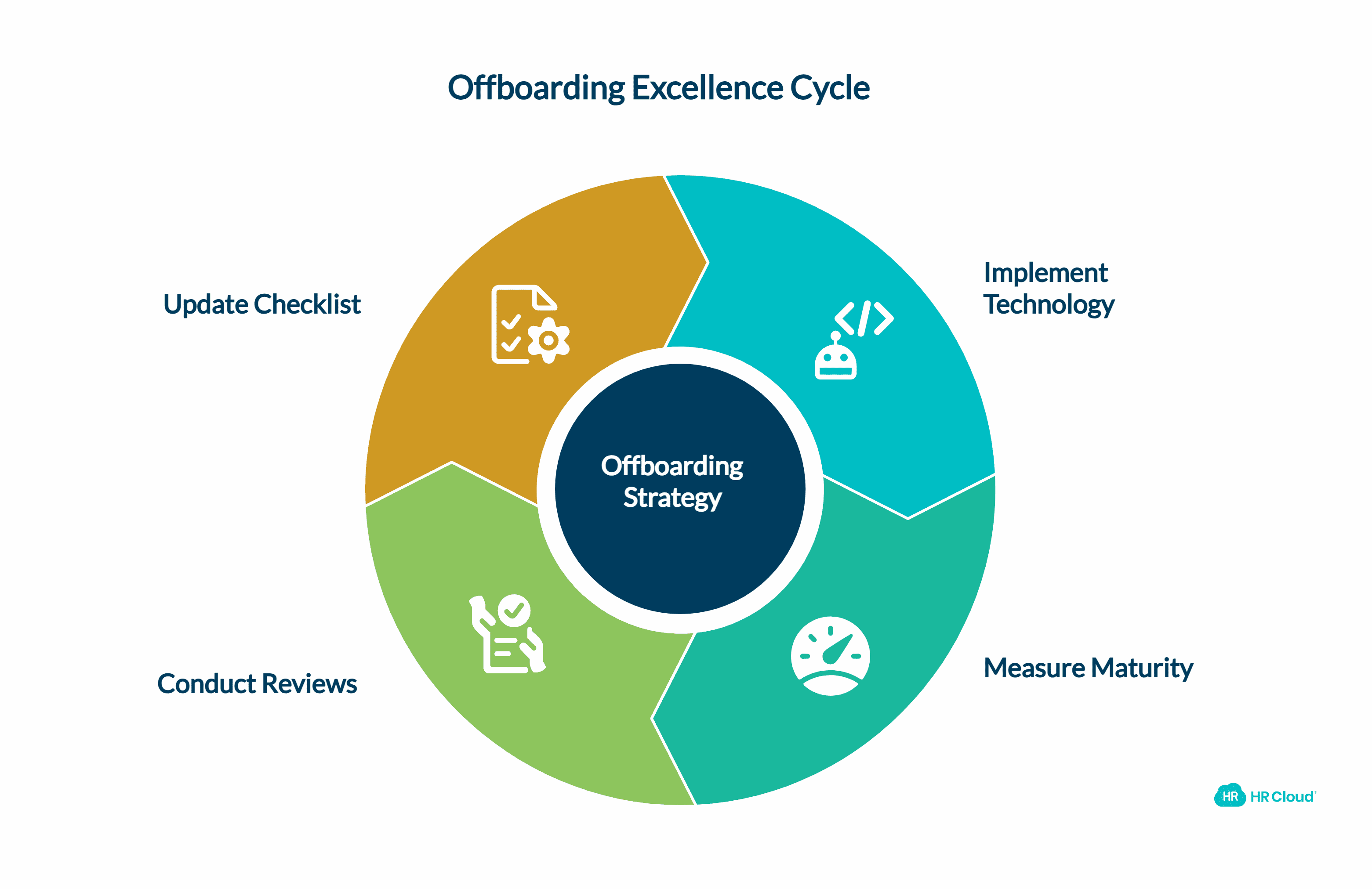
Transforming this comprehensive framework into operational reality requires three key elements: proper tooling, executive sponsorship, and continuous refinement.
Technology Enablement
The most effective offboarding processes leverage technology to ensure consistency and reduce manual effort:
Workflow Automation: Implement dedicated offboarding modules within your HRIS or use process automation platforms (ServiceNow, Pega, Appian) to orchestrate the full task ecosystem.
Digital Checklists: Deploy interactive task management that provides real-time visibility into completion status and automatically escalates delayed items.
Integration Fabric: Connect your core offboarding system with departmental tools (IT ticketing, finance systems, CRM) to ensure seamless cross-functional execution.
Measuring Offboarding Maturity
Establish these KPIs to evaluate your offboarding effectiveness:
-
Process Completion Rate: Percentage of checklist items successfully executed (target: 98%)
-
Timeline Adherence: Percentage of tasks completed within designated timeframes (target: 95%)
-
Security Incident Rate: Security events attributable to offboarding gaps (target: zero)
-
Knowledge Transfer Effectiveness: Successor ramp-up time compared to baseline (target: <80% of standard)
-
Compliance Violation Rate: Regulatory issues stemming from offboarding failures (target: zero)
Continuous Improvement Cycle
Establish a regular rhythm of process evaluation and refinement:
-
Conduct quarterly reviews of offboarding metrics against targets
-
Gather feedback from process owners about friction points and gaps
-
Monitor regulatory changes that might require process adjustments
-
Benchmark against industry peers and adopt emerging best practices
-
Update your checklist regularly to incorporate new systems and requirements
Conclusion: Offboarding as Strategic Advantage
A comprehensive employee offboarding process represents far more than administrative housekeeping-it's a strategic capability that protects your organization while strengthening your talent brand. By implementing the structured approach outlined in this guide, HR executives transform what could be moments of vulnerability into demonstrations of operational excellence.
The 50+ tasks detailed across our five phases provide the foundation for building an offboarding capability that differentiates your organization in several critical dimensions:
-
Risk Management: Systematically closing security, knowledge, and compliance gaps
-
Experience Design: Creating dignified transitions that preserve relationships
-
Operational Excellence: Demonstrating process maturity through consistent execution
-
Organizational Learning: Converting departures into improvement opportunities
In today's dynamic talent marketplace, how you handle endings speaks volumes about your organizational values and operational sophistication. Employees-both those departing and those remaining-notice the difference between haphazard processes and thoughtful protocols. So too do customers, partners, and future talent evaluating your organization.
By elevating offboarding from administrative afterthought to strategic priority, you not only mitigate immediate risks but build long-term competitive advantage through protected institutional knowledge, enhanced security posture, and a strengthened employer brand that positions your organization as a destination of choice in the talent marketplace.
Download our customizable offboarding toolkit with workflow templates, process automation guides, and departmental sub-checklists to accelerate your implementation.
FAQ’s
What is employee offboarding?
Employee offboarding is the structured process by which an organization transitions an employee out of the company when they leave, whether due to resignation, retirement, termination, or other reasons. It covers all steps needed to successfully separate an employee, including deactivating access, collecting company property, processing final pay, and completing legal and administrative requirements.
Why is a formal offboarding process important?
A formal offboarding process helps protect the organization’s assets and information, ensures compliance with legal and regulatory requirements, preserves institutional knowledge, and supports a positive employer brand. It also provides an opportunity to gather valuable feedback from departing employees.
Who is involved in the offboarding process?
The process typically involves the departing employee, their manager or supervisor, the HR department, IT for access revocation, Payroll for final compensation, and sometimes legal counsel for compliance matters.
When does the offboarding process begin?
The offboarding process begins once Human Resources is notified of the employee’s intent to leave. HR then initiates the process by sending out checklists and notifications to relevant departments.
What are the key steps in the offboarding process?
-
Notification of departure to stakeholders
-
Conducting an exit interview
-
Knowledge transfer and documentation
-
Revocation of system and physical access
-
Collection of company property
-
Processing final pay and benefits
-
Completing legal and compliance paperwork
How is company property returned?
The supervisor is responsible for collecting all company property from the departing employee, such as laptops, phones, ID badges, keys, and credit cards, typically on or before the last working day. A checklist helps ensure all items are accounted for.
How is access to company systems handled?
IT is notified to revoke the departing employee’s access to all company systems, email, internal networks, and software applications, effective on their last working day to maintain security.
What is an exit interview and why is it important?
An exit interview is a meeting with the departing employee to discuss their reasons for leaving, gather feedback on their experience, and identify areas for organizational improvement. This feedback can help HR teams enhance retention and workplace culture.
What happens with the final paycheck and benefits?
HR and Payroll ensure the departing employee receives their final paycheck, which includes any outstanding salary, unused vacation pay, and other compensation owed. HR also provides information on post-employment benefits and options for continuing coverage, such as COBRA in the U.S.
What documentation is required during offboarding?
Documentation may include a resignation letter, termination paperwork, confidentiality agreements, non-compete clauses, and any other legal forms related to the employee’s departure. HR guides the employee through completing these documents.
How can the offboarding process impact the company’s employer brand?
A respectful and efficient offboarding process leaves departing employees with a positive impression of the company, increasing the likelihood they will speak favorably about their experience and recommend the organization to others.
Author:
This article is written by a marketing team member at HR Cloud. HR Cloud is a leading provider of proven HR solutions, including recruiting, onboarding, employee communications & engagement, and rewards & recognition. Our user-friendly software increases employee productivity, delivers time and cost savings, and minimizes compliance risk.
Keep Reading
How to Streamline Enterprise Offboarding: Lessons from a Global Enterprise's Journey
Why Offboarding Deserves Strategic Attention
Organizations invest enormous resources
The Complete Employee Offboarding Checklist: 50+ Critical Tasks HR Can't Miss
The moment an employee submits their resignation or receives notice of termination, the
15 Employee Offboarding Templates That Save Hours of HR Time [Free Downloads]
Offboarding is often treated as a last-minute scramble: HR hastily drafts exit emails,
Like What You Hear?
We'd love to chat with you more about how HR Cloud® can support your business's HR needs. Book Your Free Demo

Build a Culture of Recognition. Boost Engagement. Guaranteed.
Workmates empowers employees to stay informed, connected, and appreciated—whether they’re on the front line, in the office, or remote. Recognition drives 12x higher engagement.Trusted by industry leaders in every sector




Cut Onboarding Costs by 60%.
Take the confusion and follow-ups out of onboarding with automated workflows, digital forms, and structured portals—so new hires ramp faster 3X quicker.Trusted by industry leaders in every sector





